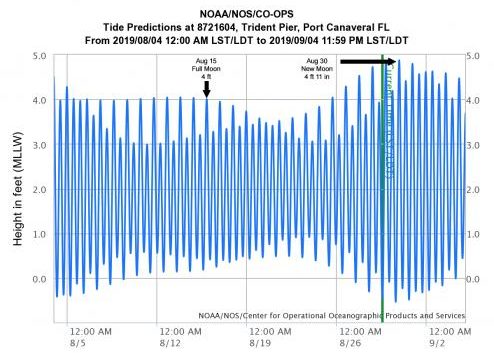- Weather Impact Alert: Tornado Watch issued for much of Southeast Texas until 9 p.m.
- Colorado State University predicts above-average 2025 Atlantic Hurricane Season
- South and Midwest face potentially catastrophic rains and floods while reeling from tornadoes
- Deadly 2024 hurricanes prompt WMO to retire three names
- Body recovered in North Carolina identified as East TN man who has been missing ever since Hurricane Helene
Hurricane with high tides adds to threats for Florida

There is never a good time for a hurricane, but the latest models from NOAA’s National Hurricane Center point to Dorian arriving at an even less convenient time, near a perigean new moon.
The tides are caused by gravitational interaction between the Earth, Moon and Sun. Oceans bulge toward the Moon and another bulge forms on the opposite side as the Earth itself is pulled towards the Moon. This produces higher highs and lower lows called king tides. These are also known as spring tides. Not spring in the seasonal sense but spring as in the tides leap quickly up the shoreline.
Newton’s law of universal gravitation tells us that the closer objects are, the greater their gravitational attraction. This is why tidal effects are greatest the few days around perigee, when the Moon is at the closest point in its elliptical orbit.
None of this is unusual. New and full moons happen about every 2 weeks and 3 or 4 of those each year occur near perigee. This generally raises tides a few more inches causing some minor coastal flooding in especially low lying areas.
But combine all of these with strong onshore winds, or the storm surge associated with a hurricane, and the risk and impacts of flooding can increase significantly.
In 2012, Hurricane Sandy moved through the Caribbean as a Category 1 storm, strengthened to a Category 3 as it hit Cuba, then weakened as it moved along the east coast and downgraded from Category 1 before it made landfall again north of Atlantic City, N.J. The timing couldn’t have been much worse. The full moon fell on the day Sandy made its landfall in the nation’s most populous city just 2 days before perigee. Storm surge flooded New York City streets and subways, costing an estimated $65 billion in damages in along the east coast.
This week’s new moon occurred Friday morning. Five hours later, the Moon was at perigee, about 30,0000 miles closer than it was at apogee. The National Hurricane Center’s latest forecast has Dorian’s winds and torrential rains arriving along Florida’s Atlantic coast late Monday or early Tuesday, when the high tide will be only a few inches lower in most locations.
Looking at a location near the middle of this threat, at the weather station at the U.S. Navy’s submarine dock at Cape Canaveral, Fla., NOAA is predicting one of the highest tides of the year on Friday night, nearly one foot higher than the tide that accompanied the Aug. 15 full moon. Measurements at this station are already about 6-12 inches higher than the math tells us they should be under normal conditions.
Based on Dorian’s latest forecast, the ADCIRC, a series of ocean circulation models developed in part by Rick Luettich, director of UNC’s Institute of Marine Science, is also showing a significant risk of flooding along the Indian River, the intracoastal waterway along Florida’s Atlantic coast.